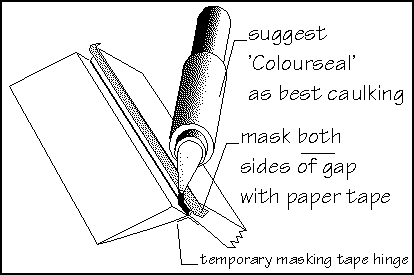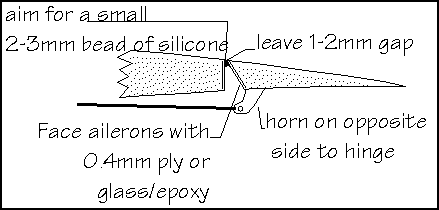How to Make Silicone Hinges

This is a simple way to hinge foam wings. I found this method very durable and I have even smashed a wing and found the hinge unbroken. The natural elasticity of the silicone rubber wants to pull the hinge back to its neutral position so there should be no problems with centring.
The technique does require some practice to get the size of the silicone bead just right. Practice first on scrap wood.
Not all the varieties of silicone caulking that are available are suitable. I found that the most expensive one, Colourseal (UK brand - ed), to be the best.
Applying the silicone

After you have cut the aileron or flap from the wing,
- Face the cuts with either 0.4mm ply or fibre glass and epoxy.
- Make a temporary hinge with paper masking tape, leaving a small gap of 1-2mm.
- Mask off the area where you don't want the caulking to go with strips of masking tape. Press the tape down well.
- Hold the gap open and run a thin bead of silicone along the gap. Smooth out the silicone with a match stick or similar diameter rod. Excess silicone rubber will come off as you do this.
Aim to get the bead as uniform as possible and in contact with the surfaces along the length of the aileron and wing. A correct diameter bead means a light hinge; if it's too stiff you used too much! Mind you, for flaps you might want a stiff hinge.
When you are satisfied with your efforts, remove the tape masking from the sides of the wing and aileron and return the aileron to the neutral position with tape at each end to secure it. Leave overnight.
When the silicone rubber has dried, carefully remove the temporary paper tape hinge from the top of the wing by peeling it slowly back on itself. (Only use paper masking tape as this enables the caulking to dry effectively.)
Covering the gap.
 To complete the hinge, some method of covering the chamfer gap is needed. Some folk use drafting film but I found chrome self adhesive handlebar tape (about �1.50 per roll from Halfords) does the job nicely. It is stiff enough to stay flat, yet flexible enough to bend with the down-going aileron.
To complete the hinge, some method of covering the chamfer gap is needed. Some folk use drafting film but I found chrome self adhesive handlebar tape (about �1.50 per roll from Halfords) does the job nicely. It is stiff enough to stay flat, yet flexible enough to bend with the down-going aileron.
At around 22% of the chord (on my model) it may also be acting as a high speed turbulator strip - in fact, I extend the tape along the length of the wing.
Cut a strip wide enough to go over the gap and stick the tape in place on the wing. To prevent the exposed tape from sticking to the aileron I cut thin strips of plastic from one of those clear plastic multipunched pockets and stick them to the exposed tape.
